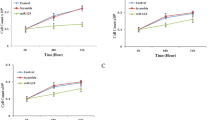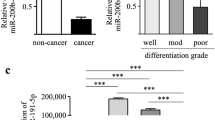Abstract
Endothelial cells are the key components of vascular intima and play pivotal roles in vasculogenesis, angiogenesis, and tumor growth. Using Northern blot and real-time PCR, we confirmed that miR-126 and its host gene EGF-like domain 7 (EGFL7) were widely expressed in rat tissues but strictly expressed in endothelial cells. In mammals, miR-126 gene is embedded in intron7 of EGFL7. To explore the biogenesis of miR-126, plasmid EGFL7(126)-pEGFPc1 containing segment of exon7-intron7-exon8 of EGFL7 was constructed and expressed in 293T. Expression of spliced exon7–8 and excised mature miR-126 was detected by PCR and Northern blot. Knocking-down of endothelial endogenous miR-126 did not affect EGFL7 expression at mRNA or protein level. To investigate the possible roles of miR-126, PicTar, miRBase, miRanda, Bibiserv, and Targetscan were used to screen the targets. VEGFA and PIK3R2 were confirmed as the targets of miR-126 by luciferase reporter assay and Western blot. Interestingly, Northern blot and western blot showed that miR-126 was down-regulated in breast tumors where the VEGF/PI3K/AKT signaling pathway was activated. Introduction of miR-126 mimics into MCF-7 could effectively decrease VEGF/PI3K/AKT signaling activity. In summary, miR-126 was strictly expressed in endothelial cells and excised from EGFL7 pre-mRNA without affecting splicing and expression of its host gene. In addition, miR-126 could target both VEGFA and PIK3R2, and its expression was decreased in human breast cancer, implying that miR-126 may play a role in tumor genesis and growth by regulating the VEGF/PI3K/AKT signaling pathway.





Similar content being viewed by others
References
Cleaver O, Melton DA (2003) Endothelial signaling during development. Nat Med 9(6):661–668. doi:10.1038/nm0603-661nm0603-661[pii]
Coultas L, Chawengsaksophak K, Rossant J (2005) Endothelial cells and VEGF in vascular development. Nature 438(7070):937–945. doi:nature04479[pii]10.1038/nature04479
Carmeliet P, Jain RK (2000) Angiogenesis in cancer and other diseases. Nature 407(6801):249–257. doi:10.1038/35025220
Campagnolo L, Leahy A, Chitnis S, Koschnick S, Fitch MJ, Fallon JT, Loskutoff D, Taubman MB, Stuhlmann H (2005) EGFL7 is a chemoattractant for endothelial cells and is up-regulated in angiogenesis and arterial injury. Am J Pathol 167(1):275–284. doi:167/1/275[pii]
Fitch MJ, Campagnolo L, Kuhnert F, Stuhlmann H (2004) EGFL7, a novel epidermal growth factor-domain gene expressed in endothelial cells. Dev Dyn 230(2):316–324. doi:10.1002/dvdy.20063
Parker LH, Schmidt M, Jin SW, Gray AM, Beis D, Pham T, Frantz G, Palmieri S, Hillan K, Stainier DY, De Sauvage FJ, Ye W (2004) The endothelial-cell-derived secreted factor EGFL7 regulates vascular tube formation. Nature 428(6984):754–758. doi:10.1038/nature02416nature02416[pii]
De Maziere A, Parker L, Van Dijk S, Ye W, Klumperman J (2008) EGFL7 knockdown causes defects in the extension and junctional arrangements of endothelial cells during zebrafish vasculogenesis. Dev Dyn 237(3):580–591. doi:10.1002/dvdy.21441
Yancopoulos GD, Davis S, Gale NW, Rudge JS, Wiegand SJ, Holash J (2000) Vascular-specific growth factors and blood vessel formation. Nature 407(6801):242–248. doi:10.1038/35025215
Carmeliet P (2003) Angiogenesis in health and disease. Nat Med 9(6):653–660. doi:10.1038/nm0603-653nm0603-653[pii]
Dimmeler S, Zeiher AM (2000) Akt takes center stage in angiogenesis signaling. Circ Res 86(1):4–5
Liu W, Ahmad SA, Reinmuth N, Shaheen RM, Jung YD, Fan F, Ellis LM (2000) Endothelial cell survival and apoptosis in the tumor vasculature. Apoptosis 5(4):323–328
Pettersson A, Nagy JA, Brown LF, Sundberg C, Morgan E, Jungles S, Carter R, Krieger JE, Manseau EJ, Harvey VS, Eckelhoefer IA, Feng D, Dvorak AM, Mulligan RC, Dvorak HF (2000) Heterogeneity of the angiogenic response induced in different normal adult tissues by vascular permeability factor/vascular endothelial growth factor. Lab Invest 80(1):99–115
Bartel DP (2004) MicroRNAs: genomics, biogenesis, mechanism, and function. Cell 116(2):281–297. doi:S0092867404000455[pii]
Stefani G, Slack FJ (2008) Small non-coding RNAs in animal development. Nat Rev Mol Cell Biol 9(3):219–230. doi:nrm2347[pii]10.1038/nrm2347
Tarantino C, Paolella G, Cozzuto L, Minopoli G, Pastore L, Parisi S, Russo T (2010) miRNA 34a, 100, and 137 modulate differentiation of mouse embryonic stem cells. FASEB J. doi:fj.09-152207 [pii] 10.1096/fj.09-152207
Schoolmeesters A, Eklund T, Leake D, Vermeulen A, Smith Q, Force Aldred S, Fedorov Y (2009) Functional profiling reveals critical role for miRNA in differentiation of human mesenchymal stem cells. PLoS One 4(5):e5605. doi:10.1371/journal.pone.0005605
Esquela-Kerscher A, Slack FJ (2006) Oncomirs—microRNAs with a role in cancer. Nat Rev Cancer 6(4):259–269. doi:nrc1840[pii]10.1038/nrc1840
Lagos-Quintana M, Rauhut R, Yalcin A, Meyer J, Lendeckel W, Tuschl T (2002) Identification of tissue-specific microRNAs from mouse. Curr Biol 12(9):735–739. doi:S0960982202008096[pii]
Bartel DP (2009) MicroRNAs: target recognition and regulatory functions. Cell 136(2):215–233. doi:S0092-8674(09)00008-7[pii]10.1016/j.cell.2009.01.002
Zhao Y, Samal E, Srivastava D (2005) Serum response factor regulates a muscle-specific microRNA that targets Hand2 during cardiogenesis. Nature 436(7048):214–220. doi:nature03817[pii]10.1038/nature03817
Chen JF, Mandel EM, Thomson JM, Wu Q, Callis TE, Hammond SM, Conlon FL, Wang DZ (2006) The role of microRNA-1 and microRNA-133 in skeletal muscle proliferation and differentiation. Nat Genet 38(2):228–233. doi:ng1725[pii]10.1038/ng1725
Soncin F, Mattot V, Lionneton F, Spruyt N, Lepretre F, Begue A, Stehelin D (2003) VE-statin, an endothelial repressor of smooth muscle cell migration. EMBO J 22(21):5700–5711. doi:10.1093/emboj/cdg549
Ruby JG, Jan CH, Bartel DP (2007) Intronic microRNA precursors that bypass Drosha processing. Nature 448(7149):83–86. doi:nature05983[pii]10.1038/nature05983
Wang S, Aurora AB, Johnson BA, Qi X, McAnally J, Hill JA, Richardson JA, Bassel-Duby R, Olson EN (2008) The endothelial-specific microRNA miR-126 governs vascular integrity and angiogenesis. Dev Cell 15(2):261–271. doi:S1534-5807(08)00281-5[pii]10.1016/j.devcel.2008.07.002
Fish JE, Santoro MM, Morton SU, Yu S, Yeh RF, Wythe JD, Ivey KN, Bruneau BG, Stainier DY, Srivastava D (2008) miR-126 regulates angiogenic signaling and vascular integrity. Dev Cell 15(2):272–284. doi:S1534-5807(08)00287-6[pii]10.1016/j.devcel.2008.07.008
Ivey KN, Muth A, Arnold J, King FW, Yeh RF, Fish JE, Hsiao EC, Schwartz RJ, Conklin BR, Bernstein HS, Srivastava D (2008) MicroRNA regulation of cell lineages in mouse and human embryonic stem cells. Cell Stem Cell 2(3):219–229. doi:S1934-5909(08)00057-X[pii]10.1016/j.stem.2008.01.016
Tavazoie SF, Alarcon C, Oskarsson T, Padua D, Wang Q, Bos PD, Gerald WL, Massague J (2008) Endogenous human microRNAs that suppress breast cancer metastasis. Nature 451(7175):147–152. doi:nature06487[pii]10.1038/nature06487
Chen CH, Lai JM, Chou TY, Chen CY, Su LJ, Lee YC, Cheng TS, Hong YR, Chou CK, Whang-Peng J, Wu YC, Huang CY (2009) VEGFA upregulates FLJ10540 and modulates migration and invasion of lung cancer via PI3 K/AKT pathway. PLoS One 4(4):e5052. doi:10.1371/journal.pone.0005052
Lee S, Chen TT, Barber CL, Jordan MC, Murdock J, Desai S, Ferrara N, Nagy A, Roos KP, Iruela-Arispe ML (2007) Autocrine VEGF signaling is required for vascular homeostasis. Cell 130(4):691–703. doi:S0092-8674(07)00905-1[pii]10.1016/j.cell.2007.06.054
Acknowledgments
This study was supported by the grants from the Major State Basic Research Development Program of the People’s Republic of China (Nos. 2009CB521902, 2009CB521907, 2007CB947002, and 2006CB503807) and the National Natural Science Foundation of China (Nos. 30971231, 30800375, 30670760, and 30570397).
Disclosures
None.
Author information
Authors and Affiliations
Corresponding authors
Electronic supplementary material
Below is the link to the electronic supplementary material.
11010_2011_723_MOESM1_ESM.ppt
Figure. S1 (A) The sequence of miR-126-3p and 5p are highly conserved in human, rat and mouse, fish and chicken. (B) Location of miR-126 in EGFL7 in human, mouse and rat. Figure. S2 Green fluorescence was observed in 293T which were transfected with pEGFPc1-EGFL7(126) (A) and pEGFPc1(B) after 24 h. (C) Luciferase activity was measured in 293T which were co-transfected of PGL3-VEGFA or PGL3-PIK3R2 with pEGFPc1-EGFL7(126) or pEGFPc1. Firefly luciferase was normalized to renilla luciferase. * P < 0.05 compares to controls. (PPT 343 kb)
Rights and permissions
About this article
Cite this article
Zhu, N., Zhang, D., Xie, H. et al. Endothelial-specific intron-derived miR-126 is down-regulated in human breast cancer and targets both VEGFA and PIK3R2. Mol Cell Biochem 351, 157–164 (2011). https://doi.org/10.1007/s11010-011-0723-7
Received:
Accepted:
Published:
Issue Date:
DOI: https://doi.org/10.1007/s11010-011-0723-7




